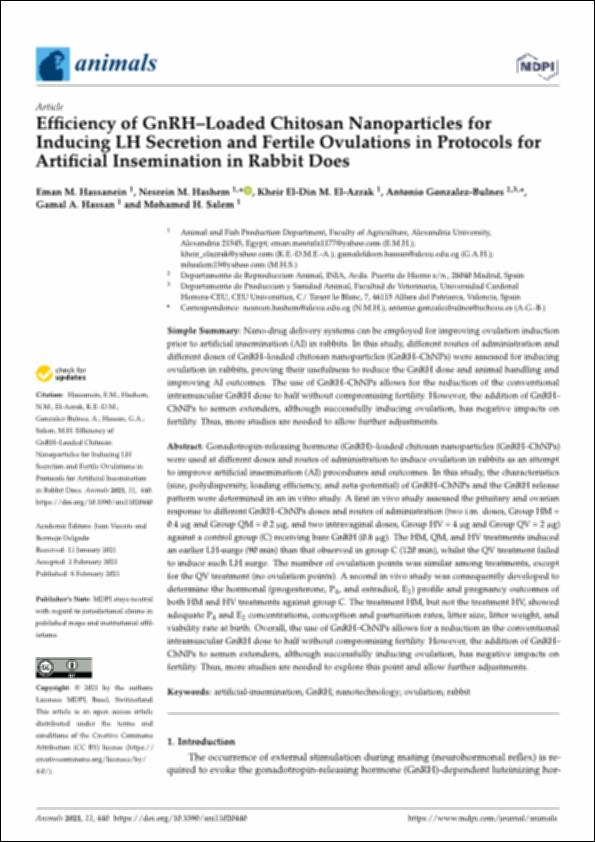Por favor, use este identificador para citar o enlazar este ítem:
http://hdl.handle.net/10637/13350Efficiency of GnRH-loaded chitosan nanoparticles for inducing LH secretion and fertile ovulations in protocols for artificial insemination in rabbit does
| Título : | Efficiency of GnRH-loaded chitosan nanoparticles for inducing LH secretion and fertile ovulations in protocols for artificial insemination in rabbit does |
| Autor : | Hassanein, Eman M. Hashem, Nesrein M. El-Azrak, Kheir El-Din M. González de Bulnes López, Antonio Hassan, Gamal A. Salem, Mohamed H. |
| Materias: | Conejos - Inseminación artificial.; Estro.; Rabbits - Reproductive technology.; Rabbits - Artificial insemination.; Conejos - Reproducción asistida.; Estrus. |
| Editorial : | MDPI |
| Citación : | Hassanein, E.M., Hashem, N.M., El-Azrak, K.E.-D.M., Gonzalez-Bulnes, A., Hassan, G.A. & Salem, M.H. (2021). Efficiency of GnRH–loaded chitosan nanoparticles for Inducing LH secretion and fertile ovulations in protocols for artificial insemination in rabbit does. Animals, vol. 11, i. 2 (08 feb.), art. 440. DOI: https://doi.org/10.3390/ani11020440 |
| Resumen : | Gonadotropin-releasing hormone (GnRH)–loaded chitosan nanoparticles (GnRH–ChNPs) were used at different doses and routes of administration to induce ovulation in rabbits as an attempt to improve artificial insemination (AI) procedures and outcomes. In this study, the characteristics (size, polydispersity, loading efficiency, and zeta-potential) of GnRH–ChNPs and the GnRH release pattern were determined in an in vitro study. A first in vivo study assessed the pituitary and ovarian response to different GnRH–ChNPs doses and routes of administration (two i.m. doses, Group HM = 0.4 g and Group QM = 0.2 g, and two intravaginal doses, Group HV = 4 g and Group QV = 2 g) against a control group (C) receiving bare GnRH (0.8 g). The HM, QM, and HV treatments induced an earlier LH-surge (90 min) than that observed in group C (120 min), whilst the QV treatment failed to induce such LH surge. The number of ovulation points was similar among treatments, except for the QV treatment (no ovulation points). A second in vivo study was consequently developed to determine the hormonal (progesterone, P4, and estradiol, E2) profile and pregnancy outcomes of both HM and HV treatments against group C. The treatment HM, but not the treatment HV, showed adequate P4 and E2 concentrations, conception and parturition rates, litter size, litter weight, and viability rate at birth. Overall, the use of GnRH–ChNPs allows for a reduction in the conventional intramuscular GnRH dose to half without compromising fertility. However, the addition of GnRH– ChNPs to semen extenders, although successfully inducing ovulation, has negative impacts on fertility. Thus, more studies are needed to explore this point and allow further adjustments. |
| Descripción : | Este artículo se encuentra disponible en la siguiente URL: https://www.mdpi.com/2076-2615/11/2/440 Este artículo pertenece al número especial "Nanotechnology in Animal Science". |
| URI : | http://hdl.handle.net/10637/13350 |
| Derechos: | http://creativecommons.org/licenses/by/4.0/deed.es |
| ISSN : | 2076-2615 (Electrónico) |
| Fecha de publicación : | 8-feb-2021 |
| Centro : | Universidad Cardenal Herrera-CEU |
| Aparece en las colecciones: | Dpto. Producción y Sanidad Animal, Salud Pública Veterinaria y Ciencia y Tecnología de los Alimentos |
Los ítems de DSpace están protegidos por copyright, con todos los derechos reservados, a menos que se indique lo contrario.


